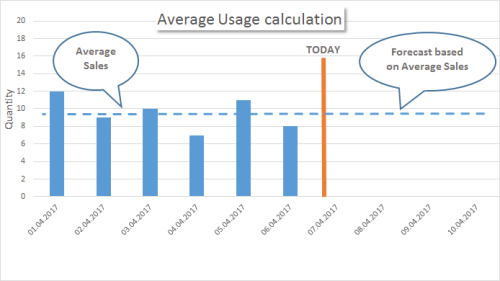The Average Usage calculation type uses sales history, the average sales per day, to predict the future sales of the item.

The Average Usage method calculates the Average Daily Sales for an item in each location based on the period defined in a Sales Profile. The sales history can be adjusted and the predicted sales data can be overwritten by definition. Days without stock on hand can be excluded for the daily sales calculation.
Average Usage setup
The following table describes a sequence of setup tasks with links to the topics that describe them. The tasks are listed in the order in which they are generally performed.
| To | See |
|---|---|
| Set up time horizons for historical data to calculate the Average Sales. | Replenishment Sales Profile |
| Set up comparison periods to calculate seasonal and/ or trend influences. | Forward Sales Profile (Store/Warehouse) |
| Set up a Replenishment calendar to link sales events with a moving date (for example Easter). | Replenishment Calendar |
| Set up an Out of Stock calculation to exclude OOS days from Average Sales calculation. | Out of Stock Days |
| Adjust historical sales to smoothen sales peaks due to one-time events. | Sales History Adjustment |
| Plan future demand peaks. | Planned Sales Demand |
| Learn more about the calculation process. | Calculation Process for Average Usage |
Fields
Fields for Average Usage calculation type
Common Replenishment data fields are described in Common Replenishment Data Fields.
| Field | Description |
|---|---|
| Store Coverage Days Profile | This field tells the system how many days of sale the inventory at the store is supposed to cover with various factors like Location Closed Days, Inbound Location Handling Time, and Coverage Buffer Days to be considered in stock coverage days calculation, and also automatically adjust the coverage to reflect the days until the next replenishment calculation. This field is used for the replenishment calculation types Average Usage, Manual Estimaten and LS Forecast. For more information see Replen. Coverage Days Profile. Note: When the Store Coverage Days Profile is not defined, the system directly uses the value from the Store Stock Cover Reqd (Days) field. |
| Store Stock Cover Reqd (Days) | This field tells the system how many days of sale the inventory at the store is supposed to cover. The field is used for the replenishment calculation types Average Usage, Manual Estimate, and LS Forecast. Example: If the system calculates that the average daily sales quantity is 5 and the Store Stock Cover Days value is 10, the system suggested quantity will be 50. |
| Wareh Coverage Days Profile | This field tells the system how many days of sale the inventory at the warehouse is supposed to cover with various factors like Location Closed Days, Inbound Whse. Handling Time, and Coverage Buffer Days to be considered in stock coverage days calculation, and also automatically adjust the coverage to reflect the days until the next replenishment calculation. This field is used for the replenishment calculation types Average Usage, Manual Estimate, and LS Forecast. For more information see Replen. Coverage Days Profile. Note: When the Wareh Coverage Days Profile is not defined, the system directly uses the value from the Wareh Stock Cover Reqd (Days) field. |
| Wareh Stock Cover Reqd (Days) | This field works the same way as Store Stock Cover Reqd (Days), but here this field tells the system how many days of sale the inventory at warehouse is supposed to cover. |
| Replenishment Sales Profile | The system uses the Replenishment Sales Profile to calculate average daily sales. |
| Store Forward Sales Profile | If you want to use last year’s sales to find the sales trend in the store, you can enter the code for the Forward Sales Profile here. |
| Wareh Forward Sales Profile | If you want to use last year’s sales to find the sales trend in the warehouse, you can enter the code for the Forward Sales Profile here. |
| Replenish as Item No. | If you have a new item that does not have any sales history and you want to use the sales history of a different item for the replenishment run, you can enter the other item number here. The replenishment system will calculate average daily sales for the other item and use the outcome for the new item. |
| Enable Lead Time Calculation |
This field tells the system whether the Vendor Lead Time (for Purchase) or Sourcing Location Lead Time (for Transfer) will be considered during the replenishment calculation for the item. The field is used for the replenishment calculation types Average Usage, Manual Estimate, and LS Forecast.
For more information see Lead Time Calculation. |
See Also
Calculation Type – Manual Estimate
Calculation Type – Stock Levels
Calculation Type – Like for Like
Calculation Type – LS Forecast